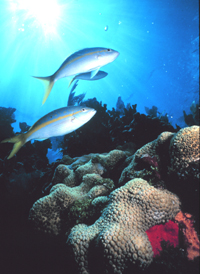NOAA Begins Ocean Data Integration Effort
April 30, 2008

High Resolution (Credit: NOAA)
NOAA has launched a major initiative to link together a wealth of ocean observation data from a wide variety of federal and non-federal sources.
The project will make ocean temperature, salinity, water level, current, wind and wave data gathered by NOAA and other organizations easier to access and use than ever before.
“NOAA is proud to lead this national effort to link ocean observations in an easy-to-use, standard format that provides accurate and timely information so people can make informed business and recreational decisions,” said Zdenka Willis, director of the NOAA Integrated Ocean Observing Program. ”NOAA and our partner organizations will use the integrated data to improve forecasts of severe weather and natural hazards, enhance pollution tracking models, and create a more complete picture of our ocean planet.”
NOAA will begin the effort by linking online databases maintained by the NOAA National Data Buoy Center, NOAA Center for Operational Oceanographic Products and Services, and the NOAA CoastWatch Program using Web services and standards developed by Open Geospatial Consortium (OGC), Inc.
“We are pleased to support NOAA in its effort to improve access, integration and use of important ocean observations collected and managed by many organizations,” said OGC President and CEO Mark Reichardt. “The use of interoperable standards to study the ocean ecosystem will help to yield a range of environmental, social and economic benefits.”
OGC is comprised of more than 350 companies, government agencies, research organizations, and universities participating in a process to develop interoperable web-based specifications and make them publicly available.
The National Oceanic and Atmospheric Administration, an agency of the U.S. Commerce Department, is dedicated to enhancing economic security and national safety through the prediction and research of weather and climate-related events and information service delivery for transportation, and by providing environmental stewardship of our nation's coastal and marine resources. Through the emerging Global Earth Observation System of Systems (GEOSS), NOAA is working with its federal partners, more than 70 countries and the European Commission to develop a global monitoring network that is as integrated as the planet it observes, predicts and protects.
